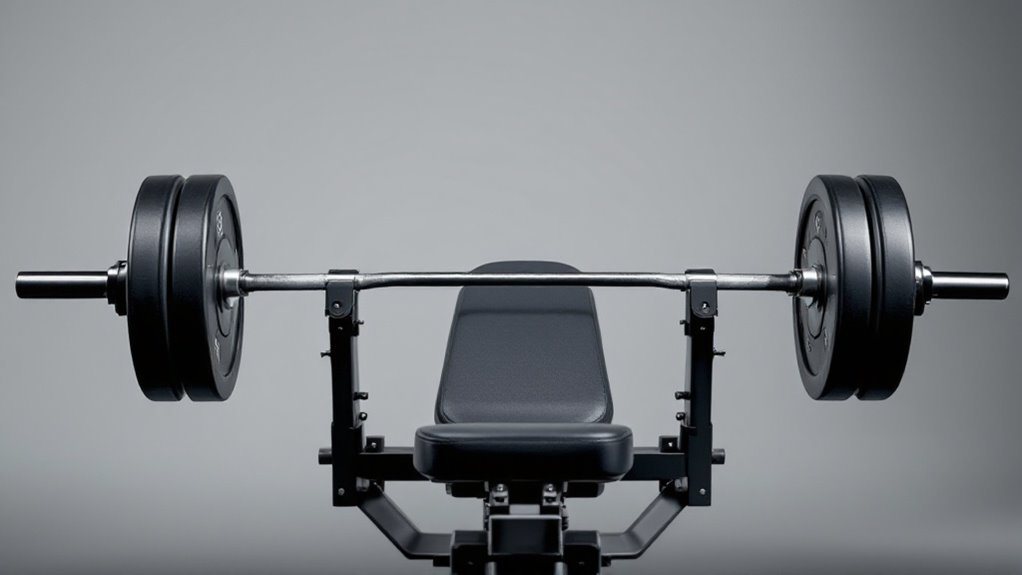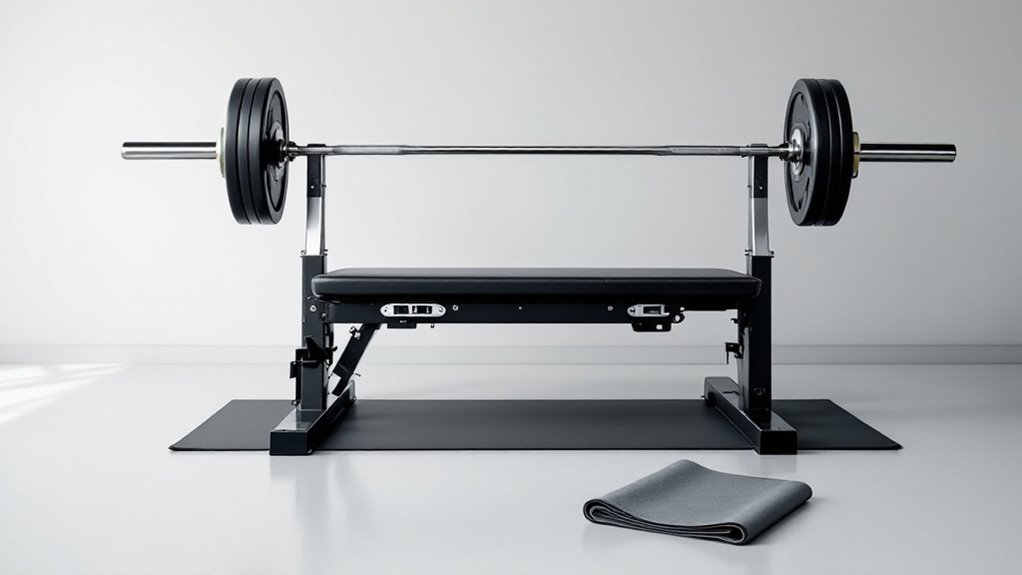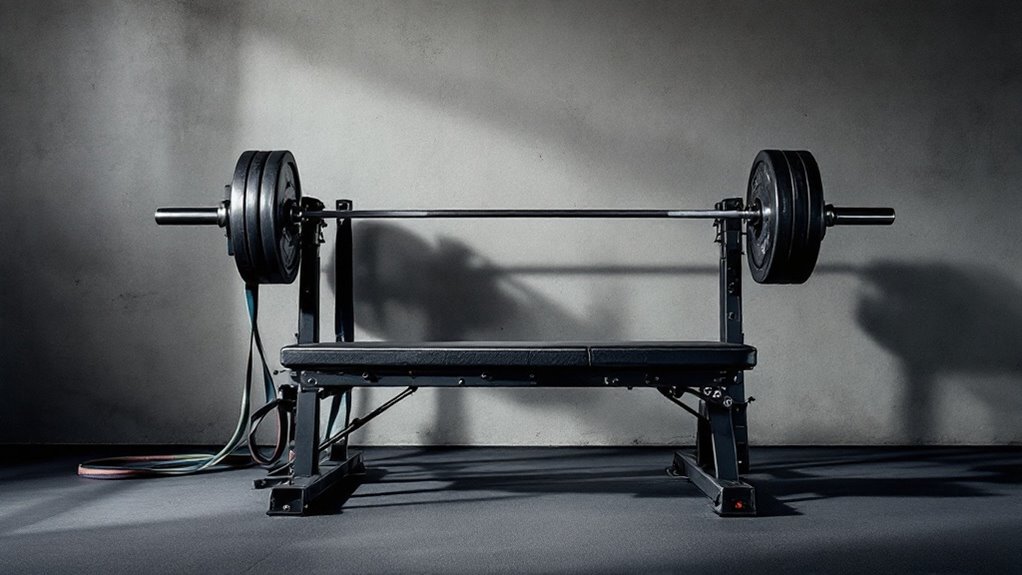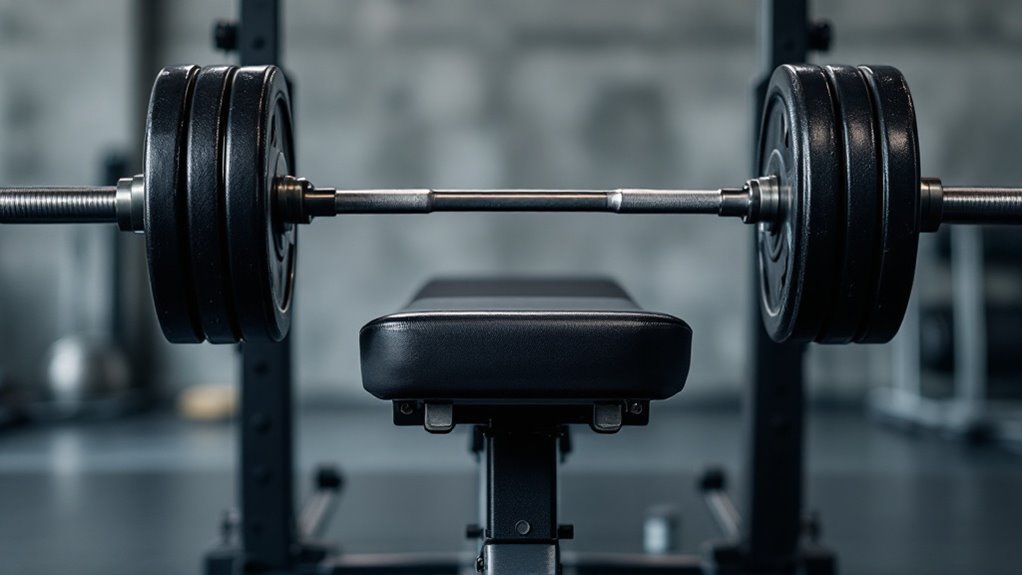Seated Shoulder Press With Barbell

The seated barbell shoulder press builds impressive shoulder strength and mass while engaging all three deltoid heads. Proper form requires sitting on a bench with back support, feet flat, and gripping the barbell slightly wider than shoulder-width. The movement begins at clavicle level, pressing overhead with controlled motion while maintaining core tension. Training 1-2 times weekly with 3 sets of 8-12 reps develops functional pressing power. Mastering this foundational exercise opens the path to balanced upper body development.
Key Takeaways
- Position yourself on a bench with back support, feet flat on ground, and grip the barbell slightly wider than shoulder-width.
- Press the barbell from clavicle level overhead while exhaling, maintaining straight wrists and 90-degree elbows throughout the movement.
- Keep core engaged and avoid excessive back arching while performing controlled pressing motions up and down.
- Perform 3 sets of 8-12 repetitions, allowing 48-72 hours between shoulder training sessions for proper recovery.
- Maintain proper external shoulder rotation and proper form to protect rotator cuff muscles and ensure optimal shoulder stability.
Proper Form and Technique

Every successful seated shoulder press begins with establishing a solid foundation through proper positioning and technique.
The lifter should position themselves on a bench with back support, feet planted firmly on the ground, and core activated. The barbell should be gripped slightly wider than shoulder-width, with wrists straight and elbows at 90 degrees.
Proper setup is crucial: support your back, plant your feet, engage your core, and grip the bar with proper form.
Starting from the clavicle level, press the barbell overhead in a controlled motion while exhaling.
The movement should follow a slight arc, avoiding the face, until arms are fully extended.
Lower the weight with control, maintaining tension throughout the negative portion of the movement.
This exercise effectively targets the deltoid muscles while engaging secondary muscle groups like the triceps and upper chest.
Key Benefits and Muscle Groups

The seated shoulder press delivers multiple powerful benefits while targeting several key muscle groups throughout the upper body. This compound movement primarily involves the deltoids, triceps, and upper chest muscles while requiring stabilization from the core and back muscles.
- Develops impressive shoulder mass and strength by targeting all three deltoid heads simultaneously.
- Builds functional pressing power that translates to everyday pushing movements and other exercises.
- Creates balanced upper body development while reducing risk of injury through proper form and stability.
When performed consistently with proper form, this exercise serves as a cornerstone movement for building formidable upper body strength and muscular development. Women can effectively incorporate this exercise into their weekly training routine to achieve their strength and toning goals.
Common Mistakes to Avoid

Despite the seated shoulder press's effectiveness, many fitness enthusiasts compromise their results and risk injury by making preventable mistakes during execution.
Common errors include arching the back excessively, flaring the elbows too far out, failing to maintain proper core involvement, and using momentum to drive the weight upward.
Other frequent mistakes are gripping the barbell too wide or too narrow, neglecting proper breathing technique, and pushing the head forward during the press.
Most critically, lifters often sacrifice form by attempting weights that are too heavy, leading to compensatory movements that can strain the lower back and shoulders.
Maintaining proper external shoulder rotation during the press is essential for protecting the rotator cuff muscles and ensuring optimal shoulder stability throughout the movement.
Training Tips and Programming

Successful shoulder press programming requires careful attention to volume, intensity, and recovery to optimize strength gains while preventing overtraining.
Smart shoulder training means finding the sweet spot between pushing hard enough for gains and allowing sufficient recovery between sessions.
Beginners should start with 3 sets of 8-12 repetitions, gradually progressing to more advanced protocols as strength develops.
- Train shoulders 1-2 times per week, allowing 48-72 hours between sessions for adequate recovery
- Incorporate progressive overload by increasing weight 2.5-5 pounds when all prescribed reps can be completed with proper form
- Combine with complementary exercises like lateral raises and face pulls for balanced shoulder development
Following a periodized training program helps systematically structure your shoulder training for maximum strength development over time.
Proper programming guarantees consistent progress while minimizing injury risk and maintaining balanced muscular development across all three deltoid heads.
Frequently Asked Questions
Can I Perform Seated Shoulder Press if I Have Lower Back Problems?
Individuals with lower back problems should approach shoulder presses with caution.
Using proper back support and maintaining correct form is vital. The seated position can provide stability and reduce spinal stress compared to standing variations.
However, consulting a healthcare professional or physical therapist before attempting this exercise is essential. They may recommend modifications or alternative exercises based on the specific back condition.
Which Is Better: Seated or Standing Barbell Shoulder Press?
Like two soldiers preparing for battle, both seated and standing barbell shoulder presses offer unique advantages.
Standing presses involve more core muscles and promote better overall stability, while seated variations provide improved isolation and reduced lower back stress.
For raw strength development, standing presses typically allow heavier weights.
However, seated presses offer better form control and are safer for those with stability concerns.
Is It Safe to Do Seated Shoulder Press Without a Spotter?
Performing seated shoulder presses without a spotter can be safe when proper precautions are taken.
Using a rack with safety pins, maintaining strict form, and working within manageable weights are essential. Beginners should start light to master technique.
For heavier lifts, dumbbells offer a safer alternative as they can be dropped to the sides if needed.
Never compromise form or attempt maximal loads without spotting.
How Much Weight Should a Beginner Start With for Seated Shoulder Press?
Beginners should start with just the barbell (45 pounds) or even lighter training bars (15-35 pounds) to master proper form.
Women may begin with 20-30 pounds, while men typically start with 30-45 pounds. The key is perfecting technique before adding weight.
Once form is solid, gradual increases of 2.5-5 pounds per session maintain safety and build strength systematically.
Can Seated Shoulder Press Help Improve My Bench Press Performance?
The shoulder press directly strengthens the deltoids, triceps, and upper chest muscles, which are essential for bench press performance.
By developing these supporting muscle groups, lifters can improve their overall pressing power and stability.
Furthermore, the seated position helps isolate proper pressing mechanics, which transfers to improved form during bench press movements.
Regular shoulder pressing can lead to better bench press numbers and reduced risk of shoulder injuries.
Final Thoughts
The seated barbell shoulder press is a cornerstone exercise that separates the wheat from the chaff in upper body training. When executed with proper form, this compound movement builds impressive shoulder strength and muscular development. By avoiding common pitfalls, maintaining strict technique, and following smart programming principles, lifters can unleash their overhead pressing potential and achieve remarkable results in their shoulder development journey.


